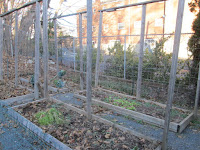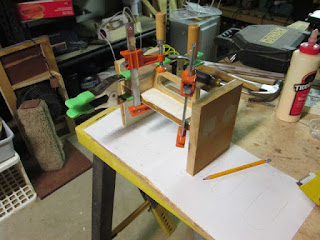Today, in a desperate effort to avoid thinking about the upcoming election, I started looking again at some of the material I used for my article on the
middle class in America. And this time, it struck me that the various ways of defining the middle class (and, by extension, the wealthy and the poor) were not just different, but in some ways contradictory.
Take us as an example. According to this article at
CNN Money, the "most common" way of defining the middle class is based on income. There are various ways you can divvy up the U.S. population to figure out who's in the middle, but most of them agree that Brian and I are part of it. The article cites one common formula created by the Pew Research Center, which defines middle class as anywhere from two-thirds of the median income to twice the median for a given household size. And according to this
calculator on the Pew website, a household of two people with our income falls smack dab in this middle range. So according to Pew, we're neither rich nor poor; we're solidly middle-income.
But, of course, there's a problem with defining wealth based on income alone. As CNN points out, your social class really has more to do with how much you spend than how much you make, because this "more accurately reflects your well-being." If your income varies widely from year to year (as mine does), you don't suddenly cease to be middle-class just because you're having an especially good or bad year.
So CNN also cites the formula created by Professor James X. Sullivan of Notre Dame, which measures class based on how much you spend on all your needs (food, housing, transportation, etc.) and wants (such as entertainment). It specifically excludes costs for health care and education, since those could be considered investments for the future rather than expenses in the present. Sullivan defines the middle class as those whose spending in these areas falls in the middle quintile for all U.S. households. For a family of four, that's $38,200 to $49,900.
Now, if you define middle class this way, it looks like Brian and I no longer make the cut. Our annual spending (not counting "investment" spending like health insurance and retirement contributions) is lower than the minimum for a middle-class family. Granted, our household has only two people, not four, but there's nothing in the article to suggest Sullivan actually makes any adjustment for this. So it looks like, as far as he's concerned, we're too poor—or at least, we're
living too much like poor people—to qualify as middle-class. And we certainly couldn't be considered wealthy.
But there's a problem with this definition, too. Defining class based on spending, rather than income, makes it possible for a family to raise its position by borrowing money—living a middle-class lifestyle that's financed with debt. But a family that takes home $45,000 a year and then spends all of it and then some isn't really well off; it's steadily losing ground. It hardly makes sense to say they're better off than a family down the street that's bringing in $40,000 and spending only $30,000, gradually building up more wealth every year.
Based on that reasoning, it makes more sense to define class based on overall wealth—in other words, net worth. CNN cites a third formula, developed by Professor Edward Wolff of NYU that defines the middle class as all those households whose net worth falls into the middle three quintiles for the country as a whole—that is, anywhere between $0 and $401,000. And according to this definition, Brian and I still don't qualify for middle class—but for the opposite reason. Wolff's formula bumps Brian and me out of the middle class and into the ranks of the wealthy. So while Sullivan considers us too poor for the middle class, Wolff considers us too rich.
Now here's what's bothering me about all this. Most people looking at the CNN article would tend to assume that the various definitions of the middle class, the poor, and the wealthy generally apply to the same group of people. Sure, using spending rather than income may put a few more people into the middle group, while going by wealth may include fewer. But in general, those who make the most money are also those who spend the most and, over time, accumulate the most—right?
Well, no, not really. Because when you look at the numbers for me and Brian, it's plain to see that our net worth is higher than normal for our income, while our spending is lower than normal. And once you think about those three numbers together, it makes perfect sense that this would be the case. The whole reason we have more money than most of our peers in the same income group is
because we don't spend as much. Spending less than your income naturally means you save more, and saving more naturally means you build up more wealth. This isn't a surprise result; it's exactly what you'd expect. Except that, if you were relying on the standard definitions of the middle-class and the wealthy, you wouldn't.
The real problem here is that each formula is looking at just one of these numbers—income, spending, or net worth—by itself. But in reality, these three numbers are linked—and not in a positive way. Yes, it's often the case that the more you earn, the faster your net worth grows. But the more you spend of what you earn, the
slower your net worth grows. And a real understanding of wealth needs to account for this.
So I think the most important number to consider isn't income (how much you make), or expenses (how much you spend), or even net worth (how much you have already). Instead, it's a frugal person's favorite line in the budget:
how much you save. By looking at this one number, you can tell instantly, at a glance, by how much you're getting ahead—or falling behind—each year.
That's the number that people should really be comparing if they want to see how they're doing relative to their peers.
Now technically, this number doesn't measure how wealthy you are right now; instead, it measures how much wealthier you're growing. But here's the thing: I think for most people, that's what's they really care most about. As this article from the
Christian Science Monitor points out, a classic definition of the middle class centers on "upward mobility coupled with a measure of financial stability": not just where you are, but where you're going. Simply put, people are more likely to feel well off when their financial position is getting better—regardless of where it is right now.
I'm not the first person to suggest this. Financial reporter Bob Sullivan, in "
The Restless Project," argued that many Americans who look well-off on paper feel financially insecure because "they are working harder, and perhaps making more money than they'd ever dreamed, but yet falling behind anyway." And conversely, financial writer Donna Freedman declared back in 2007 that she was not just surviving but
"thriving" on $12,000 a year, because she was building up her savings and even had enough to give to charity.
I don't have enough actual data to come up with a full-fledged formula for gauging your social class based on your savings rate. I can feel pretty confident in saying that anyone who's saving more than half of what they make every year—no matter how little that is—is doing well, and anyone who's saving nothing is not. There's a lot of middle ground in there, and I'm not sure at what point along that spectrum the average person would feel financially comfortable. But I do know this: it has to be somewhere in that range. Anyone who is saving nothing—no matter how much they make—is not going to feel financially secure, nor should they.
I'm not saying that savings is the only number that matters, and income and net worth are irrelevant. But it is definitely
a number that matters—and as far as I can tell, it's the one number no one is looking at.





































